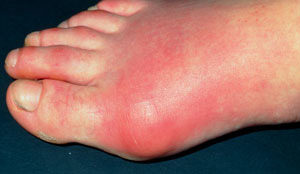Symptoms of gout
The main symptom of gout is a sudden attack of severe pain in one or more joints, typically your big toe.
Other symptoms can include:
- The joint feeling hot and very tender, to the point of being unable to bear anything touching it.
- Swelling in and around the affected joint.
- Red, shiny skin over the affected joint.
- Peeling, itchy and flaky skin as the swelling goes down.
The intense pain can make getting around difficult. Even the light pressure of a bed cover or blanket can be unbearable.
Which joints can be affected?
Gout can affect almost any joint and can occur in more than one joint at the same time. The joints towards the ends of the limbs tend to be affected more often, including the:
- Toes – particularly the big toe joint
- Midfoot (where your shoelaces sit)
- Ankles
- Knees
- Fingers
- Wrists
- Elbows
If gout is left untreated, it’s likely to affect more joints over time.
Pattern of symptoms
Attacks of gout tend to:
- Occur at night, although they can happen at any time
- Develop quickly over a few hours
- Last between three and 10 days – after this time, the affected joint should start to return to normal, but the problem can persist if treatment isn’t started early
- Come back – you may experience attacks every few months or years
- Become more frequent over time if not treated
It’s difficult to predict how often attacks will occur and when exactly they will happen.
When to seek medical advice
See your GP if you suspect you have gout and it hasn’t been previously diagnosed. Contact your GP immediately or call if you have both:
- Severe, worsening joint pain and swelling
- A high temperature (fever) of 38C (100.4F) or above
This could mean you have an infection inside the joint. If you’ve already been diagnosed with gout and you have an attack, see your GP if any medication you’ve been prescribed doesn’t start working within a couple of days.
Source: NHS UK
http://www.nhs.uk/Conditions/Gout/Pages/Symptoms.aspx

